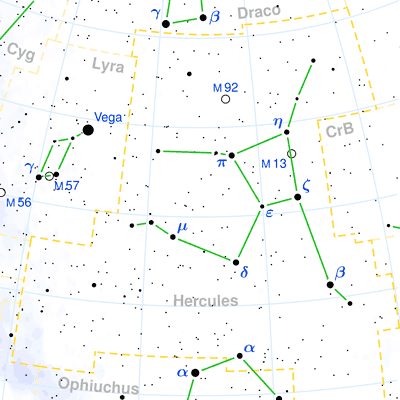The Constellation of Hercules
Image credit : Torsten Bronger CC BY-SA3.0 Published in seasky.org
The constellation of Hercules, named after the Roman mythological hero adapted from the Greek hero Heracles, is famous for its two spectacular globular clusters M13 and M92. It is not that difficult to find although its stars are not particularly bright. In July Hercules is almost overhead. Globular Clusters M13 and M92 are both easily visible through binoculars in dark skies and appear as a small fuzzy ball, but through a larger telescope they explode into a myriad of stars. These clusters reside just beyond the milky way and in our galaxy’s halo.M13 is perhaps the finest globular cluster in the Northern Hemisphere and in a very dark site is visible to the naked eye. It appears bright because it is bright. It’s visual magnitude is 5.8, but M13 has an absolute magnitude of about -8.7 which equates to more than a quarter of a million suns. In small telescopes it appears large and round with a bright core and a little irregularity at the periphery. Because or its relatively close proximity stars can be resolved right across the core. In larger telescopes it appears as a glittering ball.
M92 is ever so slightly overshadowed by M13 but is none the less a wonderful object and of the two is the hardest to find as it is in an area that has few bright stars. It is slightly smaller and less luminous than M13, with a visual magnitude of 6.1. Unlike M13 its stars have low metalicity (elements other than Hydrogen and Helium) suggesting that they were not formed from the same gas and dust as our Milky Way which is far more enriched by star formation. M92 appears more compact than M13 and requires a larger telescope to resolve stars across its core.
Interesting Stars:
- Kappa Herculis is a fine yellow double which is easily separated in small telescopes
- Gamma Herculis is another double with stars of unequal brightness
- 56 Herculis is a colour contrast double of orange and blue stars

